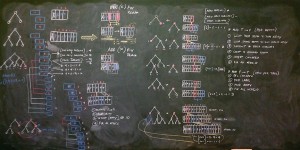When I arrived to Sutherland, with eight days and nights stretched out before me with just one principal task on my agenda, I was certain the Grow method (one of two branch mutations) was in my grasp. Yes, it evaded me for that week and another after I returned to Muizenberg. In fact, it became the single most challenging part of building Karoo GP (as noted in the email to my professor and fellow researchers May 26).
Despite the myriad sketches I produced, I was unable to see the path to fruition. I must have pursued a half dozen avenues, writing hundreds of lines of code that in the end, all failed.
I began to notice a pattern in my behaviour. I would repeatedly envision a solution. From that vantage point, I could see the challenge, the path, and the conclusion. I sketched the means, to assure it was real, and then dove into the code.
Several hours, even a day or two later, I hit a wall. Not just a small barrier, nor new challenge, but an insurmountable, unavoidable wall. With each wall, I was again reminded there was no work-around, no short-cut. The only solution invoked many stages and a great deal of coding.
How could I not have seen this? Why had this only now become no-go when just minute before, it was still possible?
I drew more sketches, more flow-diagrams, and arrived to more solutions. I even came back to an already failed solution. Having forgotten why it failed, I felt sure I must have missed something and dove back in only to be met with the same, obvious wall.
I felt stupid. Frustrated beyond belief. What’s more, my clarity of vision was diminishing rapidly. I could no longer see a half dozen steps down the coding path, but only two or three. My reduced exercise, pulling late nights with the astronomers, and change in diet all contributed.
I recall a high school art class in which we followed a book called “Drawing on the Right Side of the Brain by Betty Edwards” by Betty Edwards. One chapter advised us to hold a pencil or pen in our favoured hand, brainstorm and produce thumbnail sketches until our ideas ran dry. We felt we had surely exhausted all the possibilities for that concept.
Then we grasped the pen with the other hand, even if awkward to the majority of us who are not ambidextrous. More ideas came! Ideas from a completely different foundation.
I knew enough about my internal processes, having spent much of my undergraduate program in Industrial Design in problem solving, to recognise that I would benefit from working on something else, something that came to me more easily. I improved the interface, cleaned up the Python methods, and developed small, useful tools such as a method for tree population renumbering, another for renumbering columns in an axis-1 Numpy array, each of which represented a node in a GP tree; and ultimately, a method for tracking the differences between original and skewed node positions as a branch was inserted into a tree.
 When I returned to Muizenberg and my office with a blackboard, I drew my diagrams much larger, using my entire upper body to bring form to my visions. I was able to see the solutions more clearly than when at Sutherland.
When I returned to Muizenberg and my office with a blackboard, I drew my diagrams much larger, using my entire upper body to bring form to my visions. I was able to see the solutions more clearly than when at Sutherland.
Yet, repeatedly, when I turned to sit at my computer, the blackboard to my back, the clarity vanished quickly. I’d start typing and … hit a roadblock, or completely forget what was to happen next.
I thought I was losing my mind. I could see two, sometimes three steps at a time, but four or more and I failed miserably. Endless loops of indigestible code, a headache, backache, and neck filled with anxiety.
I returned to the blackboard, erased everything, and started over. I took the sketches deeper, down to the pseudo-code level such that I was writing loose versions of Python directly on the board.
Those tiny tools I had developed in Sutherland became invaluable, for in each was a means by which I could relieve my mind of that function, trusting the power of a tested black box. The more tools I developed, the more I could focus on flow instead of the detailed interaction of ever level of code.
Success came to me when I broke a complex problem into the smallest pieces possible, connected those pieces with each other, and then validated the flow of data across the system. From this came the “debug” mode, not integral to Karoo GP as a means by which the user can monitor the mutations in real-time.
It’s fascinating to watch, even to me.






